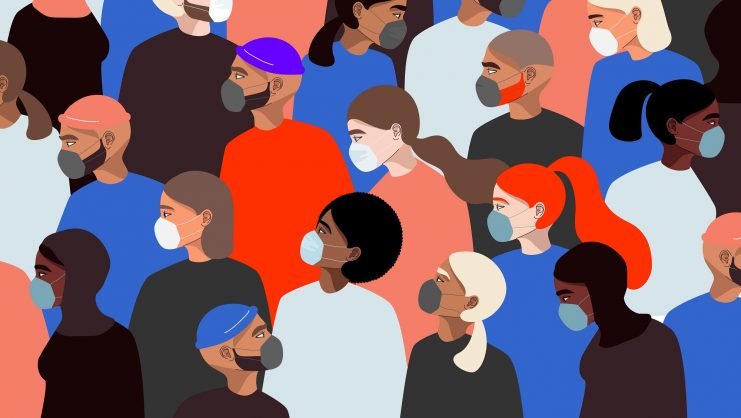Public interest and research alike tend to focus on the powerful, emblematic figures. CEOs, politicians, and ‘elite’ professionals are portrayed as deciding the fate of industries, companies, states, and the public sector. Yet, what is often overlooked is the fact that the success of every strategy or policy depends on those who execute it – and doing so takes the everyday work that is often less than glamorous.
Frontline workers are people who directly provide services to customers, clients, or patients. While their decisions and behaviors have a big impact on the individuals with whom they interact, they are not very visible to anyone else. A crisis like the current global pandemic is a powerful reminder that we depend on frontline professionals and employees to deliver medical and other essential services. In these last months, there has finally been some public recognition for frontline workers. This in turn, has prompted some much-needed reflection on how we as a society value – including financially – frontline work.
Research on the topic has also been catching up, with attention being paid to how frontline employees impact company strategy (and, vice versa) and how working conditions influence their day-to-day experiences. Having a background in the study of professions and occupations, organizations, and human resource management, it was important to me to capture the perspective of these frontline workers and to understand the what, when, how, and why of their daily work.
Everyday Problems of Medical Professionals
As medical professionals have deep and very specialized knowledge, they usually have significant autonomy in how they treat patients. That said, beginning in the 1970s, clinical guidelines have been increasingly used as detailed procedural descriptions of steps, medication, and the professionals involved in treatment, based on the diagnosis of a patient’s condition. In hospitals, these guidelines are often combined with checklists, and are therefore a good example of how health care becomes increasingly standardized.
On the one hand, standards and guidelines have the potential to increase the quality of care and transparency for patients. But they also focus primarily on the most efficient distribution of resources for everyone and therefore tend to ignore the individual patients’ situation. During the pandemic, for example, a clinical protocol caused moral outcry in Madrid because of its triage guidelines that dictated who should be treated first or hospitalized based on degree of illness and other patient characteristics such as age.
With my colleagues Hendrik Wilhelm of Witten/Herdecke University and Jessica Chromik, formerly of the University of Cologne, we have investigated the situations in which medical professionals, specifically physicians in internal medicine departments in German university hospitals, found detailed clinical guidelines helpful and why. The study, White Coats at the Coalface: The Standardizing Work of Professionals at the Frontline, revealed that these medical professionals faced a variety of problems in their everyday frontline work. One typical situation was junior physicians were overwhelmed by having to treat a large number of patients under time pressure and without the supervision of more experienced doctors. Thus, junior physicians were grateful to rely on guidelines that described efficient treatments. It’s important to note that in our study, the patients’ diseases were typically not complex, but the pressure was still enormous. With this in mind, it is worthwhile to consider the intense pressure junior medical professionals are dealing with as they push against the COVID-19 pandemic.
Blood transfusion incidents are fatal or at least extremely dangerous.
Another interesting, and quite different, example of when frontline professionals in the study appreciated clinical guidelines was when physicians had to work together with other specialists, nurses, or laboratory staff in order to administer highly complex and risky treatments. For example, blood transfusions. As one medical professional told, “Blood transfusion incidents are fatal or at least extremely dangerous.” Any error on the part of the medical professional is likely to be fatal. Therefore, in addition to the obligation for their patients, frontline professionals work under the fear of legal consequences. Sticking to checklists and guidelines was therefore how physicians dealt with everyday risky situations.
The Paradoxical Tensions Inherent in Frontline Work
While tensions might surface in any job, frontline employees experience these tensions as especially stressful. They must react to the customers’ expectations and complaints in real-time, while trying to balance the client’s demands with that of their employers. Of course, medical professionals are only one example of frontline workers. In another study, Resourcing Under Tensions: How Frontline Employees Create Resources to Balance Paradoxical Tensions, Anna Schneider and Julia Brandl, both of the University of Innsbruck, and I studied the everyday work of sales assistants in a fashion store.
The company we studied was focused on both great customer service and efficiency. While each of these goals is perfectly reasonable alone, having to simultaneously fulfill them when interacting with customers caused notable tensions for employees. In some situations, the sales assistants felt that it was simply a paradox to make the customer happy and sell more or keep company costs to a minimum. To that point, the company tracked daily sales targets for the sales assistants while expecting these same employees to provide professional (and honest) style advice. Customers were frequently disgruntled by complicated merchandise-return procedures and complained when employees could not assist them due to their tight time schedule.
How Frontline Employees Address Everyday Problems and Tensions
Witnessing and speaking with frontline employees about the tensions in their customer interactions allowed us to not only understand how frontline employees make sense of everyday problems, but also how they try to solve these issues. It was fascinating to see how creative employees can be – despite the inflexible company procedures – in their attempt to balance these tensions by “working around” rules and generally finding innovative resources common understandings and norms to satisfy the customer.
It is a good way to make customers happy again if something has made them angry.
When the company’s policies upset customers, for instance causing a long wait at the checkout desk, sales assistants tried to “make the customer happy again,” by stressing their customer orientation with apologies, thoroughly checking merchandise software, or freebies such as parking vouchers. As one sales assistant told us, “It is a good way to make customers happy again if something has made them angry.”
Another way sales assistants address tensions, even before they arise, is to anticipate which organizational procedures might frustrate customers. For instance, the moment a sales assistant puts their commission sticker on the merchandise is when most customers realize the assistant had a personal monetary interest in making the sale. One sales assistant avoided the anticipated awkwardness in a humorous way: she handed over the commission sticker to the customer and said, “These are the insignia of our success. Please put them on if you are satisfied with my service.”
The Strategic Importance of Frontline Work
Indeed, frontline workers are often impressively imaginative in how they turn the limitations of their work context into resources that enable them to manage daily challenges. That said, companies and organizations, including hospitals, should pay more attention to the working conditions and needs of their important frontline workers because these are the very individuals who transmit an organization’s strategy to its clients.
It is clear companies have a long way to go in understanding how to manage their frontline workers. Besides demanding work schedules and times, frontline employees are often invasively monitored, have to do unpaid “emotional labor,” and suffer from burnout. Employers’ appreciation of frontline workers seems limited. An especially cynical example is a Viennese hospital that “thanked” more than 200 frontline medical professionals for their effort during the COVID-19 pandemic with 12 candy bars and eight cans of peanuts.
The gig economy provides another, and unfortunately also bleak, glimpse of frontline workers that have helped us through the pandemic. Food deliverers might provide the nation with essential goods – Glovo has more than one million orders per month in Spain – but the platform companies that deliverers work for often do not provide them with even the most essential protection or rights. As frontline workers in the “gig economy” are typically forced into self-employment, their waiting times and sick days are unpaid and there is no income security.
Frontline workers have always been there for us, even when their working conditions are not ideal. For too long, this struggle has gone unnoticed but their plight and their worth has been revealed by the pandemic. We now have the opportunity and the choice to reconsider how we as a society value and show our appreciation of these essential workers at the frontline of our lives.
© IE Insights.






